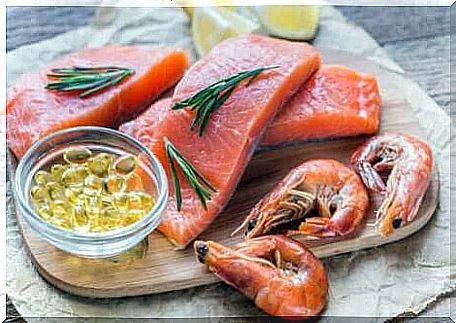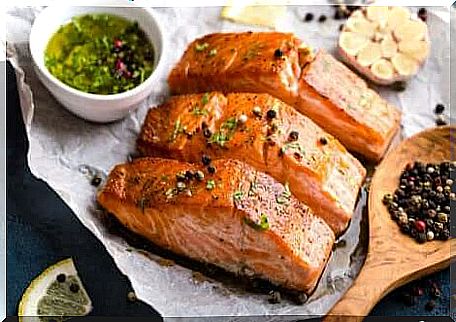High Omega-3 Fish You Should Eat
Adult people should eat at least two servings of high omega-3 fish per week. Discover some omega-3 rich fish to eat in the future in this article!

Are you trying to improve your health through your diet? Has anyone ever told you to take omega 3? In this article we are going to tell you all about this important fatty acid. We also recommend different types of fish high in omega-3s that you can eat right away.
Omega 3 is a type of unsaturated fat that the body cannot make on its own. Therefore, the only way to get it is to ingest it. This nutrient is very important for the body and helps, among other things, to improve the lipid profile and prevent cardiovascular diseases.
What are omega-3 fatty acids?

Fish contains unsaturated fatty acids. If we eat these instead of the saturated fat found in meat, it can lower cholesterol levels. However, the most important nutrients seem to be the omega-3 fatty acids that we find in particularly high-fat fish.
Omega-3 fatty acids can slightly lower triglycerides and blood pressure. At the same time, they can reduce blood clotting, strokes, and the risk of heart failure and irregular heartbeats. Current scientific findings confirm these advantages.
Why Eating Fish High in Omega-3 is Good for Heart Health
Are you worried about heart disease? Eating two to three servings of fish a week can reduce your risk of a heart attack, according to a publication in Fitoterapia magazine.
For many years, the American Heart Association has recommended eating fish high in omega-3s at least twice a week.
Some people are concerned that mercury or other contaminants in fish could negate the heart health benefits. However, when it comes to a healthier heart, the benefits of consuming fish often outweigh the potential risks of exposure to harmful substances.
High in omega-3 fish

As you would expect, high-fat fish have the highest levels of omega-3 fatty acids. The following stand out:
- Mackerel: Between 2.5 and 5 mg of omega-3 fatty acids per 100 mg of fish
- Herring: Between 1.6 and 4.3 mg per 100 mg
- Salmon: Between 1.5 and 3 mg per 100 mg
- Caviar: Between 1.8 and 2.4 mg per 100 mg
- Horse mackerel: Between 1.5 and 2.8 mg per 100 mg
- Sardine: Between 1.3 and 1.8 per 100 mg
- Tuna: Between 0.5 and 1 mg per 100 mg
White fish such as sole, hake or trout have an omega-3 content of less than 1%. So if your priority is to get this type of healthy fat, you need to choose omega-3 rich fish, which will help prevent disease.
How Much Fish Should You Eat?
- Adults should eat at least two servings of high omega-3 fish per week. One serving size is 99 grams.
- Pregnant women and young children should also consume 2 to 3 servings per week. However, you should avoid eating the larger fish like swordfish, pike, grouper, dogfish, etc. These can contain more toxins. You should preferably choose small fish that should also be well cooked.
Aside from fish, what other omega-3 rich foods can you eat?
- Nuts and seeds such as flax seeds, chia seeds, and black walnuts
- Vegetable oils such as flaxseed oil, soybean oil, and rapeseed oil
- Olive oil is a healthy part of the Mediterranean diet and a good source of omega-3 fatty acids. There are 8.3 omega-3s per 100 grams.
- Fortified foods such as certain brands of eggs, yogurt, juices, milk, and soy drinks
Include fish high in omega-3s in your diet
Finally, we would like to tell you that you can find omega-3 not only in fish, but also in fish oil, krill oil, cod liver oil or algae oil (a vegetarian alternative made from algae). These come in different doses and contain different forms of omega-3.
Check with your doctor for more information.









